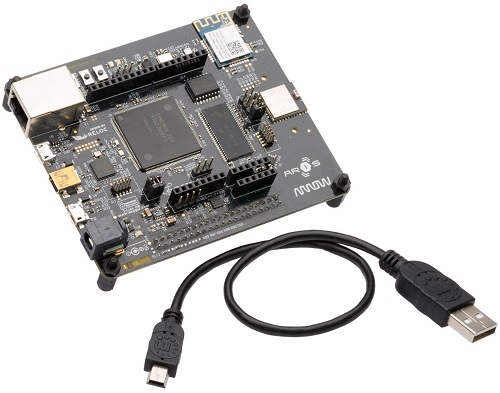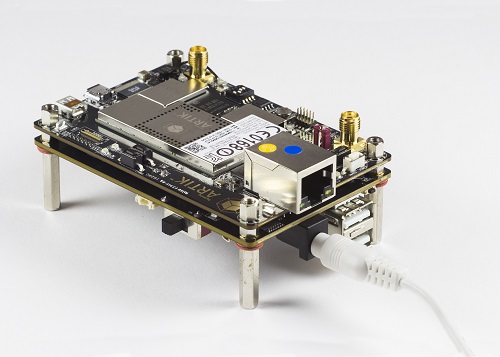By Richard Quinnell, editor-in-chief
Preparing a design to join the Internet of Things (IoT) is a great deal more involved than many developers realize. Not only does the design effort need to create the device’s hardware and embedded code, it needs to address many issues that arise out of the device’s connectivity. Fortunately, vendors have started offering platform-based development kits to help teams achieve full end-to-end functionality in their product designs.
In many ways, creating the end-node device is the easy part of IoT development. Microcontroller-based system design is a well-established discipline with many practitioners. Connecting that device to the internet, however, raises a host of issues with which many developers are not yet familiar. Take wireless connectivity, for instance. While some IoT designs will use a hardwired network connection, most will be wireless, which requires RF expertise that many development teams and individuals lack.
Then there are the opportunities and dangers of having a persistent network connection be integral to a device’s function. The opportunities include the ability to remotely activate, configure, provision, and update the connected system to simplify installation and maintenance as well as to extend the device’s utility and service life following deployment. The dangers include susceptibility to hacking to steal information and interfere with device operation.
But while some of the development needed to leverage the opportunities and mitigate the dangers is associated with the end-node device, much of the necessary development involves the network server to which the end-node device ultimately connects. For many device developers, this represents an entirely new discipline that must be mastered. Similarly, many IoT designs involve end-user interactions that connect through the network server from a computer or mobile device. The end-user application and its interaction with the server involve yet another new discipline for development teams.
Large development teams may have the resources to handle all of these technical disciplines, but many IoT development teams are small or even singular. Few of these have the resources to master the microcontroller, RF, network server software, and end-user software design all together, making IoT development problematic. Fortunately, vendors have started to take notice of this obstacle and are working to help developers overcome it.

The approach that vendors are using is the development of IoT platforms. These offerings go beyond the way that traditional embedded development has been supported for years with hardware modules and reference designs along with software drivers and operating systems. Vendors are forming partnerships with middleware vendors, web services, and applications experts to offer IoT development teams full end-to-end packages that leave only the end-node design left to do. Increasingly, these packages are addressing critical device issues such as security, provisioning, and life-cycle management, as well as system issues such as network server support, integration with enterprise software, and end-user applications.
Furthermore, these platforms are arising from both ends of the chain. Chip vendors have created fully integrated, wireless modules, like the Samsung ARTIK, that come pre-loaded with software to access the company’s own cloud services. Similarly, software-as-a-service (SaaS) vendors such as AWS (Amazon Web Services) are promoting hardware modules from partners that have already been validated to work with their service.

The degree of integration within these platforms can vary. Modules like the ARTIK and the Arrow Electronics LTE-M Starter Kit are ready to connect to cloud services out of the box. Others offer multiple service vendor options but require the developer to choose the service and then integrate the appropriate software on their own or with vendor help. Either way, however, the business of creating an IoT product has been made substantially easier with the rise of the platform approach.
To learn more about IoT platform products and services, check out these stories from around the AspenCore network:
EE Times University Series: Fundamentals of IoT System Design — There are several different IoT topologies and options that a developer can choose when designing their IoT device. In order to select the proper topology, developers need to understand each link in the IoT chain and how these links interact with each other.
Verizon Unveils ThingSpace IoT Platform — Verizon wants to connect billions of things within its 4G LTE network. The company announced an IoT development platform, ThingSpace, for connectivity in smart cities, health care, agriculture, energy, and sharing platforms.
Nokia Applies IMPACT to IoT Fragmentation — Lack of security and fragmentation are often cited as basic reasons why the IoT market has been slow to catch fire. Nokia hopes to provide pre-integrated applications that help alleviate customers’ initial trepidation before plunging into IoT.
Renesas Electronics America, Intrinsic ID, and Medium One introduce complete sensor-to-cloud platform to simplify secure IoT development — RX231 Wi-Fi cloud connectivity kit integrates Renesas RX231 MCUs, Intrinsic ID IoT authentication, and Medium One’s cloud services and workflows.
Affordable STM32 cloud-connectable kit from STMicroelectronics puts more features on-board for fast and flexible IoT-device development — The new high-connectivity STM32L4 IoT Discovery kit (B-L475E-IOT01A) from STMicroelectronics gives unrivaled flexibility for developers building IoT nodes.
4 hardware kits to speed IoT development, or to sharpen your IoT chops — Today’s hardware kits come with a wide variety of software tools, documentation, and example projects.
Advertisement
Learn more about Electronic Products Magazine





